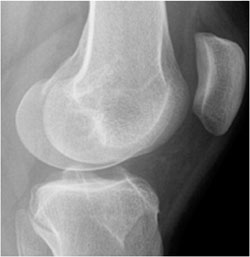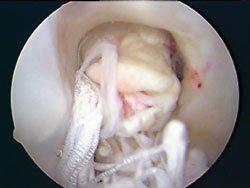Athletes benefit from extended return to play times and education after ACL repairs
Darren L. Johnson, MD, finds variations in patients, grafts and rehabilitation can affect return to sport.
|
|
The increasing number of primary and revision ACL reconstructions being performed on 13- to 24-year-old athletes indicates better ways are needed to predict who will tear their ACL and what kind of outcomes can be expected, according to a sports medicine specialist at the University of Kentucky.
“Even in the best circumstances, we are limited in predicting what happens and how they do,” Darren L. Johnson, MD, said at the American Orthopaedic Society for Sports Medicine 2009 Annual Meeting.
As a result, Johnson now focuses more on educating young athletes and their parents about what is realistic in terms of ACL healing and return to play times and encouraged other surgeons to do likewise.
Biologic basics
Johnson explained he is mainly concerned about how many patients are being cleared for full return to play after an ACL reconstruction too early. This can alter their prospects for a good long-term outcome and may even set them up for revision surgery, he noted.
|
Images: Johnson DL |
“Many patients have problems down the road. Rehab may assist, but we need to pick our patients wisely,” said Johnson, who has performed an estimated 1,500 ACL surgeries.
A proponent of performing anatomic ACL reconstructions and respecting the biology involved, Johnson encouraged his sports medicine colleagues to familiarize themselves with the basic science findings of Scott A. Rodeo, MD. He described them as especially insightful regarding characteristics of the grafts, bone tunnels, soft and hard tissue and healing.
Make adjustments
Surgeons can help reduce the increasing numbers of ACL revision and re-revision cases in patients under age 20 by making technical adjustments to their primary ACL surgical technique and being more conservative with return-to-sports recommendations, Johnson said.
Research shows that by 4 to 5 months postoperatively, when some clinicians allow patients to return to full competition in Level 1 sports, a sufficiently strong biological and neurological repair has not yet occurred, particularly with allograft tissue.
Johnson questioned the wisdom of having an adolescent high school ACL-patient come back as early as 4 months after surgery, when the majority of collegiate and professional athletes return in 7 to 12 months. “That just does not seem right to me,” he said.
“Return to Level 1 sports in my hands is at least 6 months, and if I do a revision case, it is a year.”
Patient education
Johnson suggested the following ways to improve the care and outcomes of athletes who tear their ACLs:
- educate patients about ACL healing and how to support that process during rehabilitation;
- engage parents of high school and college athletes in the treatment and rehabilitation;
- match graft selection to the patients and the method of fixation;
- slow down and extend rehabilitation when needed;
- use integrated rehabilitation to avoid permanent damage; and
- perform an examination with the pivot shift test to assess healing status before allowing full return to sport.
In the future, Johnson said he envisions athletes with ACL tears benefitting from completely individualized surgeries, rehabilitation and return-to-play times selected with their own healing characteristics, anatomy, injury pattern and kinematics in mind.
|
|
For more information:
- Darren L. Johnson, MD, can be reached in the Department of Orthopaedic Surgery, University of Kentucky, 740 S. Limestone St., Suite K415, Kentucky Clinic, Lexington, KY 40536; 859-323-5533; e-mail: dljohns@uky.edu. He is a consultant to Smith & Nephew Orthopedics.
Reference:
- Johnson DL. Lessons learned: Return to play — Are we kidding ourselves? ACL reconstruction. Presented at the American Orthopaedic Society for Sports Medicine 2009 Annual Meeting. July 9-12, 2009. Keystone, Colo.



